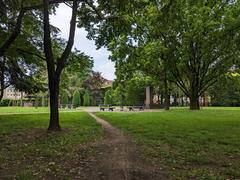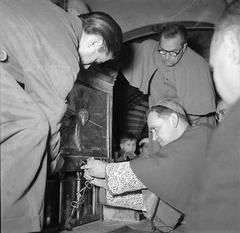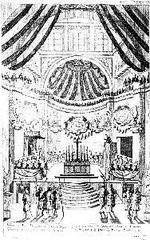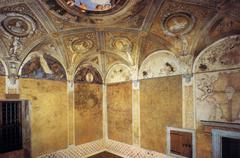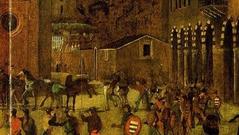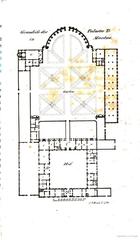Teatro Bibiena Visiting Hours, Tickets, and Mantua Historical Sites Guide
Date: 03/07/2025
Introduction
Teatro Bibiena, a jewel in the heart of Mantua, Italy, stands as one of Europe’s most exquisite examples of late Baroque and Rococo theater architecture. Designed by Antonio Galli Bibiena and inaugurated in 1769, this historic venue is celebrated not only for its stunning bell-shaped auditorium and lavish interior but also for its enduring role in Mantua’s artistic and intellectual life. This comprehensive guide covers Teatro Bibiena’s history, architectural features, visiting hours, ticketing, accessibility, and practical tips, alongside suggestions for exploring nearby Mantua historical sites (Lonely Planet; theatre-architecture.eu).
Table of Contents
- Origins and Historical Context
- Architectural Design and Features
- Artistic Decoration and Interior Details
- Facade and External Features
- Construction, Early Use, and Notable Events
- Evolution, Preservation, and Modern-Day Use
- Visitor Information: Hours, Tickets, Accessibility
- Guided Tours and Visitor Experience
- Nearby Attractions and Suggested Itineraries
- Practical Tips for a Memorable Visit
- Frequently Asked Questions (FAQ)
- Summary and Call to Action
- References
Origins and Historical Context
Teatro Bibiena, also known as Teatro Scientifico Bibiena, was commissioned by the Accademia Nazionale Virgiliana during a period when Mantua was reaffirming its reputation as a center for culture and science (Wikipedia). Built between 1767 and 1769, the theater was envisioned as a venue for both theatrical and musical performances as well as scientific lectures and academic gatherings. This dual-purpose reflects the Enlightenment ideals of interdisciplinary learning and public engagement that defined Mantua’s intellectual climate in the 18th century (Italy Chronicles).
Architectural Design and Features
The most distinctive feature of Teatro Bibiena is its innovative bell-shaped auditorium—a departure from the traditional horseshoe layout. This design enhances acoustics and creates intimacy, allowing up to 400 spectators to enjoy exceptional sound quality and sightlines (theatre-architecture.eu; artsandculture.google.com).
Surrounding the auditorium are four tiers of ornately decorated boxes, including a unique level behind the stage. The absence of a traditional proscenium arch integrates the audience with the performance space, reflecting the Bibiena family’s signature approach to theatrical architecture (guideturistichemantova.it).
Artistic Decoration and Interior Details
Antonio Galli Bibiena personally oversaw the theater’s interior decoration. The monochrome frescoes (grisaille) in subtle white and brown tones, along with elaborate stucco ornamentation featuring floral motifs, cherubs, and classical allegories, create a light and sophisticated atmosphere. The wooden ceiling, added in the 19th century, was inspired by Bibiena’s earlier work and complements the acoustics and visual harmony of the space (artsandculture.google.com; guideturistichemantova.it).
Statues of figures like Baldassarre Castiglione and Virgil emphasize the theater’s academic roots and reinforce its cultural prestige.
Facade and External Features
The neoclassical facade, designed by Giuseppe Piermarini in 1773, offers a dignified entrance that contrasts with the ornate interior. Piermarini’s design also extends to the adjacent Palazzo Accademico. The exterior’s elegance underlines the theater’s integration into Mantua’s urban and architectural heritage (spottinghistory.com; in-lombardia.it).
Construction, Early Use, and Notable Events
Completed in under two years, Teatro Bibiena opened on December 3, 1769. A highlight of its early history was the 1770 concert by a 14-year-old Wolfgang Amadeus Mozart, commemorated as a defining moment in the theater’s legacy (Wikipedia). The venue quickly became a hub for scientific demonstrations, music, and academic events.
Evolution, Preservation, and Modern-Day Use
Teatro Bibiena has undergone careful restoration to preserve its original layout, frescoes, and furnishings. The most recent renovation, completed in 2024, included new handmade terracotta flooring, restored wall finishes, improved lighting, and plush, historically accurate velvet seating (Voce di Mantova). Modern amenities such as accessible bathrooms and updated heating systems have been integrated with sensitivity to the building’s heritage.
Today, the theater is an active venue for concerts, chamber music, lectures, and special events, and hosts major cultural festivals like Festivaletteratura (Italy Chronicles).
Visitor Information: Hours, Tickets, Accessibility
- Visiting Hours: Typically open Tuesday to Sunday, 10:00 AM–6:00 PM. Last admission is usually 30 minutes before closing. Hours may vary during performances or special events; always check the official website for the latest schedule.
- Tickets: General admission ranges from €5–€10, with discounts for students, seniors, and groups. Children under a certain age are admitted free. Tickets are available at the entrance or can be reserved online, especially advisable during peak seasons (finestresullarte.info).
- Accessibility: The ground floor is fully accessible, with no stairs at the entrance, accessible restrooms, and seating accommodations. Due to the building’s historic nature, upper tiers are only accessible by stairs. For specific needs, contact the theater in advance (Voce di Mantova).
- Facilities: Basic restroom facilities are available; there is no on-site café, but numerous dining options can be found nearby.
Guided Tours and Visitor Experience
Guided tours, available in multiple languages (including English and Italian), provide rich insights into the theater’s history, architecture, and cultural significance. Tours typically last 30–45 minutes and may be booked in advance or at the box office. Self-guided visits are also welcome, with informational materials often available in several languages.
Photography is permitted during regular visits (no flash or tripods), but prohibited during performances (finestresullarte.info). Virtual tours and high-resolution images are available online for remote exploration.
Nearby Attractions and Suggested Itineraries
Located in Mantua’s historic center, Teatro Bibiena is within easy walking distance of several major attractions:
- Palazzo Ducale: Mantua’s grand Renaissance palace, featuring lavish rooms and extensive art collections.
- Basilica di Sant’Andrea: A masterpiece of Renaissance church architecture.
- Palazzo Te: Renowned for its Mannerist frescoes and gardens.
A typical itinerary might include a morning visit to Teatro Bibiena, lunch at a local trattoria, and afternoon exploration of Mantua’s palaces, piazzas, and museums. The annual Festivaletteratura literary festival often features events at the theater (finestresullarte.info).
Practical Tips for a Memorable Visit
- Advance Booking: Reserve tickets or guided tours during peak seasons and festivals.
- Dress Code: No formal requirements for daytime visits; smart attire is encouraged for performances.
- Language: Staff and guides commonly speak Italian and English; informational brochures are available in multiple languages.
- Duration: Allow 30–60 minutes for a self-guided visit, or up to 90 minutes with a guided tour and nearby exploration.
- Souvenirs: The theater occasionally offers publications or souvenirs at the ticket desk.
Frequently Asked Questions (FAQ)
Q: What are Teatro Bibiena’s visiting hours?
A: Generally Tuesday–Sunday, 10:00 AM–6:00 PM. Hours may vary during special events.
Q: How can I purchase tickets?
A: Tickets are available at the entrance or online via the official website.
Q: Is Teatro Bibiena accessible to visitors with mobility challenges?
A: The ground floor is accessible and includes adapted restrooms; upper tiers require stairs.
Q: Are guided tours available in English?
A: Yes, tours are available in English and Italian; other languages may be available upon request.
Q: Can I take photos inside?
A: Photography (without flash or tripods) is generally permitted during visits, but not during performances.
Summary and Call to Action
Teatro Bibiena is a testament to Mantua’s rich artistic and intellectual heritage, offering visitors a unique blend of architectural innovation, historic ambiance, and vibrant cultural programming. Its exquisitely restored interiors, innovative bell-shaped auditorium, and illustrious history—including Mozart’s legendary performance—make it a must-visit destination for anyone exploring Mantua historical sites (Lonely Planet; Italy Chronicles).
To make the most of your visit:
- Check the official website for current hours, ticketing, and special events.
- Consider booking a guided tour for deeper insight into the theater’s art and architecture.
- Explore nearby Mantua landmarks to enrich your experience.
- Download the Audiala app for audio guides, interactive maps, and cultural updates.
For more inspiration and planning, discover our related articles on Mantua’s Renaissance sites and follow us on social media for the latest updates.
References
- Lonely Planet
- theatre-architecture.eu
- artsandculture.google.com
- guideturistichemantova.it
- Wikipedia
- Italy Chronicles
- Voce di Mantova
- finestresullarte.info
- Histouring
- Mantova Sabbioneta UNESCO
- spottinghistory.com
- in-lombardia.it

